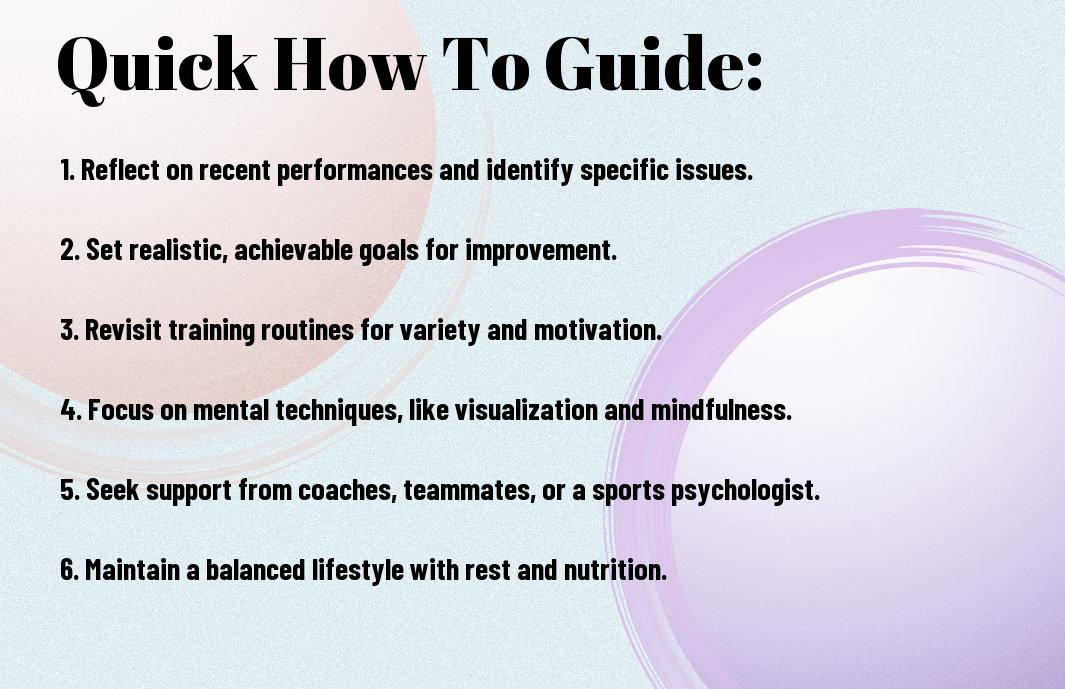You might find yourself facing a dip in your sports performance, which can be frustrating and disheartening. It’s vital to address this slump effectively to regain your confidence and improve your skills. In this guide, we’ll explore practical strategies you can implement to identify the root causes of your performance issues, boost your motivation, and enhance your training regimen. By adopting a positive mindset and making targeted adjustments, you can bounce back stronger than ever.
Key Takeaways:
- Identify Triggers: Reflect on recent performance to pinpoint specific factors contributing to the slump.
- Set Small Goals: Establish achievable objectives to gradually rebuild confidence and skill level.
- Focus on Fundamentals: Return to basic skills and techniques that may have been overlooked during challenging times.
- Seek Support: Engage coaches, teammates, or mentors for guidance and encouragement to overcome obstacles.
- Embrace Mindfulness: Incorporate mental strategies, such as visualization and relaxation techniques, to enhance focus and reduce pressure.
Understanding the Slump
The slump in sports performance can be an unsettling experience for any athlete. It often manifests as a noticeable dip in consistency, motivation, and overall ability to perform at your best. These performance slumps can stem from various factors—both physical and mental—leading to frustration and self-doubt. Acknowledging that such slumps are a natural part of the athletic journey is crucial for moving forward effectively.
Identifying Causes
Slump situations often arise from a mix of physiological, psychological, and environmental factors. You may experience fatigue, lack of focus, or even burnout, which can negatively impact your training and competitive performance. Additionally, external pressures, such as personal life stress or unrealistic expectations, can play a significant role in your current performance level.
Recognizing Signs
Causes of performance slumps can be subtle initially, but there are noticeable signs that can alert you to a decline. Pay attention to changes in your energy levels, motivation, and self-confidence. If you find yourself dreading workouts or feeling increasingly indifferent about competition, these feelings may indicate you’re entering a slump.
Signs of a performance slump can also include physical symptoms like persistent fatigue, decreased strength, or struggling with techniques that were once second nature. You might also notice increased irritability or frustration during practice. Be mindful of these indicators, as acknowledging them early can give you the insight needed to address the underlying issues effectively.

Mental Strategies
Even elite athletes face slumps, but mental strategies can help you regain your focus and performance. Developing a strong mental game is crucial for overcoming obstacles and getting back on track. Implementing techniques such as visualization and positive self-talk will empower you to push through tough times and perform at your best.
Visualization Techniques
With visualization techniques, you can mentally rehearse your performance, creating a powerful connection between your mind and body. By picturing yourself succeeding in your sport, you build confidence and reinforce your skills. This practice enables you to approach your actual performance with a clearer mindset and greater assurance.
Positive Self-Talk
You can significantly impact your performance through positive self-talk. By consciously choosing empowering and encouraging phrases, you build a stronger mental foundation. Replacing negative thoughts with affirmations helps cultivate resilience and motivation, allowing you to approach challenges with a positive attitude.
It is important to establish a consistent routine for positive self-talk during training and competition. Create a list of phrases or affirmations that resonate with you and practice saying them regularly. When faced with challenging situations, rely on these affirmations to refocus your mindset and maintain your confidence. By reinforcing your belief in your abilities, you create an empowering atmosphere that facilitates progress and helps you overcome any slump in performance.

Physical Preparation
Now that you have recognized a slump in your sports performance, focusing on your physical preparation can make a significant difference. This involves assessing your current fitness levels and determining where your body may need adjustments. A well-structured physical routine tailored to your needs will not only enhance your skills but also help you regain confidence and motivation.
Adjusting Training Regimens
Clearly, modifying your training regimen can be beneficial in overcoming performance slumps. Evaluate your current workouts and consider varying intensity, duration, or types of exercises to challenge your body differently. By introducing new elements or reducing the volume of training, you can help prevent burnout and stimulate improvements in your performance.
Importance of Proper Rest
An crucial aspect of overcoming a slump is ensuring you prioritize rest. Adequate recovery time allows your body to heal and rebuild, which is important for maintaining peak performance. Skipping rest days can lead to fatigue and diminishing returns on your efforts.
Understanding that rest is not merely a break from training, but a vital component of your physical preparation is key. Adequate sleep improves muscle repair, enhances mental focus, and boosts immunity, all of which contribute to better athletic performance. Incorporate rest days into your training schedule and pay attention to how your body responds; this adjustment can lead to a better balance between effort and recovery, ultimately helping you bounce back stronger.
Setting Goals
Keep your focus sharp by setting clear and achievable goals. When you have specific objectives, it becomes easier to track your progress and regain confidence in your abilities. Ensure that your goals are tailored to address the areas where you’re experiencing a slump, and don’t hesitate to revisit and modify them as your performance evolves.
Short-term vs. Long-term Goals
If you want to maximize your potential, it’s important to differentiate between short-term and long-term goals. Short-term goals provide motivation and immediate benchmarks, while long-term goals help you maintain your vision and purpose in your sport. Both types of goals play crucial roles in your overall performance and development.
SMART Goal Framework
Goals should be specific, measurable, achievable, relevant, and time-bound. This SMART goal framework ensures your objectives are clear and structured, fostering accountability in your training efforts. The more detailed your goals are, the better equipped you will be to evaluate your progress and make necessary adjustments.
Understanding the SMART goal framework can significantly enhance your approach to performance improvement. By developing specific goals that outline exactly what you want to achieve, you can track measurable progress over time. Ensure they are realistic and relevant to your current situation, and assign deadlines to keep yourself accountable. This structured approach allows you to focus on immediate tasks while keeping your long-term vision in mind, creating a balanced path to overcoming your performance slump.
Seeking Support
Many athletes find that overcoming a slump in performance can be significantly easier when you seek support from others. Engaging with coaches, peers, and mentors can provide fresh perspectives, encouragement, and valuable advice as you navigate through challenging times. Recognizing that you don’t have to face these obstacles alone can be empowering and can lead to renewed motivation and focus.
Working with Coaches
Support from coaches is vital in addressing performance slumps. They possess the experience and expertise to identify areas for improvement and provide tailored feedback. By maintaining open lines of communication, you can work together to develop effective strategies, set realistic goals, and create a positive training environment that fosters growth.
Engaging with Peers
Seeking support from your peers can greatly enhance your journey toward improved performance. Connecting with fellow athletes allows you to share experiences, exchange tips, and motivate each other. Collaborating during training sessions can also lead to healthier competition, pushing you beyond your limits while fostering a sense of camaraderie and teamwork.
Working alongside your peers can also help shift your mindset during challenging times. Engaging in group training or discussing your struggles openly can provide a support system that encourages accountability and resilience. By learning from each other’s successes and setbacks, you can cultivate a positive atmosphere that reinvigorates your passion for the sport and motivates you to persist through difficult moments.
Nutrition and Recovery
Despite the physical demands of your sport, proper nutrition and recovery are often overlooked yet integral to overcoming performance slumps. Fueling your body with the right nutrients not only enhances your physical capabilities but also accelerates recovery, allowing you to rebuild and perform at your best. Balancing macronutrients, staying hydrated, and following a tailored meal plan can significantly impact your training results and overall performance.
Fueling Your Body
Clearly, the foods you choose to consume directly influence your energy levels, endurance, and overall performance. Opt for a diet rich in carbohydrates, proteins, and healthy fats, and focus on whole, unprocessed foods that provide sustained energy. Incorporating nutrient-dense snacks, particularly around training sessions, can help you maintain focus and vitality throughout your workouts.
Recovery Techniques
While nutrition plays a pivotal role in fueling you for success, effective recovery techniques are imperative for repairing your muscles and preventing burnout. Implementing practices such as foam rolling, stretching, and incorporating active recovery days can enhance your body’s ability to bounce back after intense training sessions. Prioritizing sleep and utilizing hydration strategies will further support your recovery process, allowing you to maximize your gains.
For instance, consider adding contrast baths or ice baths to your routine, which can aid in reducing inflammation and muscle soreness post-workout. You may also explore the benefits of yoga, which promotes flexibility and relaxation while helping to clear your mind. Moreover, integrating light exercises, such as walking or swimming, on your rest days not only keeps blood flowing but can also reduce stiffness, ensuring you’re ready for your next training session.
To wrap up
Ultimately, overcoming a slump in sports performance requires a combination of strategies tailored to your specific needs. Focus on setting realistic goals, maintaining a positive mindset, and utilizing visualization techniques. Engage in open communication with your coaches or mentors for guidance, and consider varying your training routine to keep things fresh. Listen to your body and give yourself the necessary rest and recovery time. By implementing these methods, you can regain your confidence and elevate your performance back to its peak level.
Q: What are some common causes of a slump in sports performance?
A: Slumps in sports performance can stem from various factors including lack of motivation, physical fatigue, mental stress, or inadequate recovery periods. Additionally, external pressures such as competition results or personal expectations can intensify these feelings. Athletes may also face specific technical or tactical challenges that lead to poor performance. Recognizing these underlying issues is the first step toward addressing and overcoming them.
Q: How can mental training techniques help in overcoming a slump?
A: Mental training techniques, such as visualization, mindfulness, and goal-setting, can significantly assist athletes in overcoming slumps. Visualization involves picturing oneself successfully executing skills or achieving goals, which can enhance confidence and focus. Mindfulness practices help athletes stay present and reduce anxiety about past or future performances. Setting realistic and achievable goals can provide structure and motivation, fostering a positive mindset and a sense of progress.
Q: What role does physical conditioning play in breaking through a performance slump?
A: Physical conditioning is necessary in addressing performance slumps as it ensures that athletes are in optimal shape for their sport. Tailored training programs focusing on strength, endurance, and flexibility can help rebuild confidence in physical abilities. Additionally, incorporating rest and recovery strategies can prevent burnout and promote overall wellness, allowing athletes to perform at their best. Regular assessments and adjustments to training routines can also help address specific weaknesses or concerns that may be contributing to the slump.
